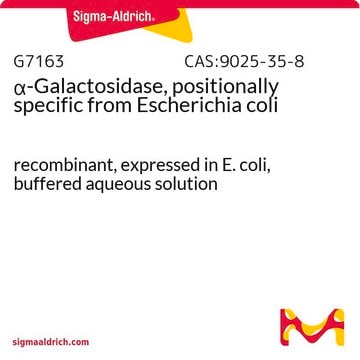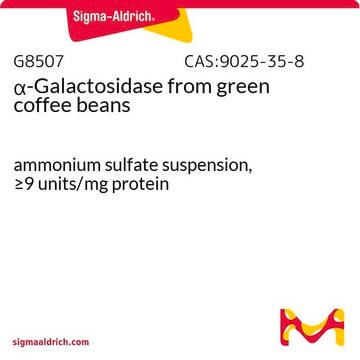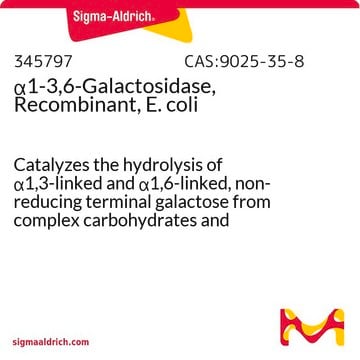G7673
α-Galactosidase I, Alkaline from Cucumis melo
Synonym(e):
α-D-Galactoside Galactohydrolase, Melibiase
About This Item
Empfohlene Produkte
Rekombinant
expressed in E. coli
Assay
≥85% (SDS-PAGE)
Form
lyophilized solid
Spezifische Aktivität
≥20 units/mg protein
Mol-Gew.
apparent mol wt ~84 kDa by SDS-PAGE
Versandbedingung
wet ice
Lagertemp.
−20°C
Allgemeine Beschreibung
Anwendung
Biochem./physiol. Wirkung
Physikalische Eigenschaften
Einheitendefinition
Physikalische Form
Signalwort
Warning
H-Sätze
Gefahreneinstufungen
Eye Irrit. 2 - Skin Irrit. 2 - STOT SE 3
Zielorgane
Respiratory system
Lagerklassenschlüssel
11 - Combustible Solids
WGK
WGK 3
Flammpunkt (°F)
Not applicable
Flammpunkt (°C)
Not applicable
Analysenzertifikate (COA)
Suchen Sie nach Analysenzertifikate (COA), indem Sie die Lot-/Chargennummer des Produkts eingeben. Lot- und Chargennummern sind auf dem Produktetikett hinter den Wörtern ‘Lot’ oder ‘Batch’ (Lot oder Charge) zu finden.
Besitzen Sie dieses Produkt bereits?
In der Dokumentenbibliothek finden Sie die Dokumentation zu den Produkten, die Sie kürzlich erworben haben.
Unser Team von Wissenschaftlern verfügt über Erfahrung in allen Forschungsbereichen einschließlich Life Science, Materialwissenschaften, chemischer Synthese, Chromatographie, Analytik und vielen mehr..
Setzen Sie sich mit dem technischen Dienst in Verbindung.








